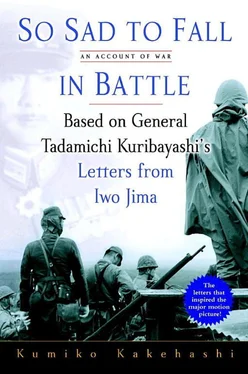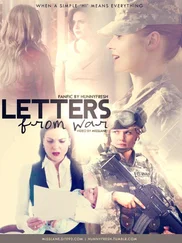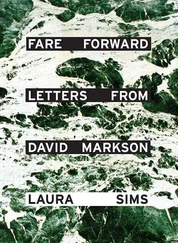The difference in their relative stations was as wide as the gulf between heaven and earth. Kuribayashi was an officer in his early fifties, while Sadaoka was in his twenties and a mere tailor. But Kuribayashi was genuinely fond of the young man. Sadaoka came from the Shikoku countryside. He had earned good grades at school, but his family was not in an economic position to send him on to college, so he had applied for the South China Expeditionary Force because he wanted to “get over to the continent and see the world.”
IT WAS FEBRUARY 2004 when I visited Sadaoka in his home near Harimaya-bashi Bridge in the center of Kôchi—almost fifty-nine years after the defeat at Iwo Jima.
After my interest in Kuribayashi had first been sparked, I found that the more research I did, the more I was drawn to the man. When a member of the Kuribayashi family told me that a onetime civilian employee of the military who had had a special bond with Kuribayashi was still alive and well, I lost no time in getting in touch.
“If you are an admirer of his lordship, then you are family as far as I’m concerned.”
As Sadaoka welcomed me with these words, he brought out a photograph. It was from 1943, he said, and had been taken in the barracks of the South China Expeditionary Force in Canton.
The picture was of the garden of the barracks. Kuribayashi in his uniform and his boots was sitting on a chair with a white seat cover, his sword in his hand. Beside him was a military dog, a German shepherd, and behind him stood five men, one of whom was the young Sadaoka.
“When they decided to have the picture taken, his lordship said, ‘This is too good an opportunity to miss. Let’s call Sadaoka,’ and he sent a messenger to fetch me. I was in my quarters inside the base, but to get from the garden where the photograph was taken to my quarters and back took a good fifteen minutes, even if you ran at full tilt. His lordship was good enough to wait for me all that time.”
Under normal circumstances it was quite unthinkable that an army officer should wait fifteen entire minutes for a mere tailor. But I imagine that Kuribayashi wanted to give Sadaoka, a country boy, the chance to have his photo taken, which was still something rare and exotic at the time. In the picture, Sadaoka is standing very upright and stiff directly behind Kuribayashi with a rather tense expression on his face.
The army was an institution where social class distinctions were carried to an extreme, and for Kuribayashi to be so open and friendly with his “inferiors” made him a most unusual officer. When soldiers were hospitalized, he would personally drive over to visit them in the military hospital, bearing gifts of fruit. He also delivered soothing ice to soldiers who suffered from malaria.
Sadaoka, who frequently accompanied Kuribayashi, said to him one day half in jest, “When they get a visit from you in person, the patients probably feel so embarrassed that they can’t sleep peacefully.”
Kuribayashi only smiled at the time, but starting with their next visit, he parked the car outside the hospital gates and would send Sadaoka in to visit the sick men on his behalf while he waited outside.
Sadaoka loved this man, Kuribayashi, more than his true father, and when Kuribayashi was promoted to lieutenant general and transferred to the Second Imperial Guards Home Division in Tokyo in June 1943, Sadaoka put in a request for a transfer and remained with him.
But a year later, when it was decided that Kuribayashi was to be sent to Iwo Jima as commander in chief, he forbade Sadaoka to go with him.
Sadaoka was in torment. In August, two months after Kuribayashi had departed for Iwo Jima, he boarded a ship bound for Chichi Jima, around 270 kilometers north of Iwo Jima, “in pursuit of his lordship.” Iwo Jima is located almost at the southernmost tip of the Ogasawara Islands, but politically it is part of Metropolitan Tokyo. It was Chichi Jima, however, that was the political and economic center of the Ogasawara Islands, and transport ships plied between there and the mainland.
Determined to be reunited with Kuribayashi, Sadaoka spent a whole night walking from Tokyo to Yokohama. After he had waited a week at the port, he came across a boat going to Chichi Jima.
“I am a civilian employee of Lieutenant General Kuribayashi. I want you to take me to his lordship,” he announced as he forced his way on board.
“Papers and written permissions? I had nothing like that with me. Frankly, I’ve got no idea why they let me on board. Maybe it was just that the war was turning against us and I was able to take advantage of the general confusion to sneak on.”
Once Sadaoka got to Chichi Jima and finally managed to get through to talk to Kuribayashi on the radio telephone, he was subjected to a stinging rebuke. “What the hell do you think you’re doing there?” bellowed Kuribayashi. “I categorically forbid you to come out to this island.”
“It was the only time his lordship had ever shouted at me—the only time.”
Sadaoka’s eyes swam with tears as he told me that he never heard Kuribayashi’s voice again.
He stayed in Chichi Jima until December of that year. Kuribayashi talked about Sadaoka in the letters he wrote to his wife, Yoshii, back in Tokyo. On December 11, 1944, he wrote:
I heard that Sadaoka will be returning to the mainland on the next ship. He took the trouble to come all this way but was unable to see me. To top it off, he got sick and had to go into hospital, and that’s what finally persuaded him to go home. When he gets back to Tokyo he’s sure to drop in on the house. When he does, don’t just keep him out in the entrance hall, but please go out of your way to be nice to him. I heard that he’s eventually planning to go back to his hometown in the country.
Kuribayashi had driven Sadaoka off because he did not want him to die in vain for his sake, and he was obviously concerned about this young man who had followed him so far to the south. Kuribayashi again mentioned Sadaoka in another letter written only eleven days later, on December 22, 1944: “I think that after taking the trouble to come out here and then having to go back to Japan without seeing me, he’ll probably end up returning to his hometown. That’s what war is like for all of us, after all.”
The expression “taking the trouble to come” appears for a second time. Clearly, Kuribayashi understood how Sadaoka, who had traveled so far in order to see him, felt toward him. His comment, “That’s what war is like for all of us,” is not so much stoic, soldierly resignation, but has a poignant ring as if he is admonishing himself.
After Sadaoka wrote to announce that he had reached Tokyo safely, Kuribayashi sent him a letter from Iwo Jima.
In reply to your esteemed letter:
Your card from Tokyo reached me. It is a pity that we could not meet here, but I am delighted that you returned safely. You mention that you were good enough to visit my house in Tokyo and I am deeply grateful for your kindness.
I am in the best of health and have continued to work hard as usual, so there is no need for concern in that regard. Farewell.
The letter is kind and warm—quite unlike the occasion when Kuribayashi shouted at him. In fact, the letter is so politely worded that you would never guess it was addressed to only a young civilian employee. It is written with neat brushstrokes on a postcard printed with the words “Army Post.” Yellowed now with the passage of almost sixty years, the postcard is carefully stored away in a safe in Sadaoka’s house.
This message was sent at the end of December 1944, when the air attacks and the naval barrage against Iwo Jima were growing ever more intense. The Americans landed less than two months later, on February 19, 1945, and Kuribayashi is thought to have died in battle at dawn on March 26.
Читать дальше












